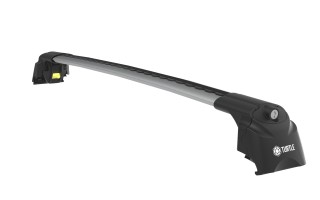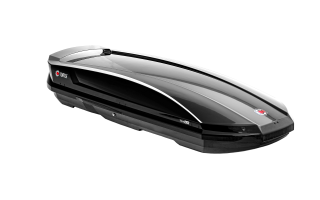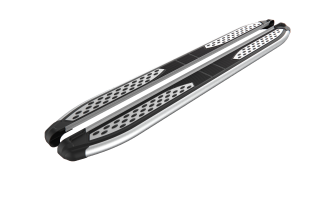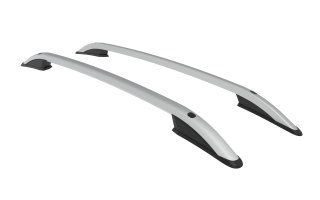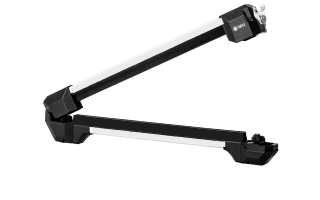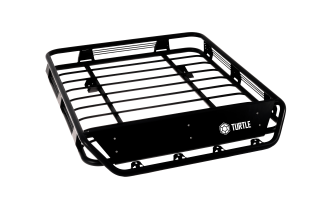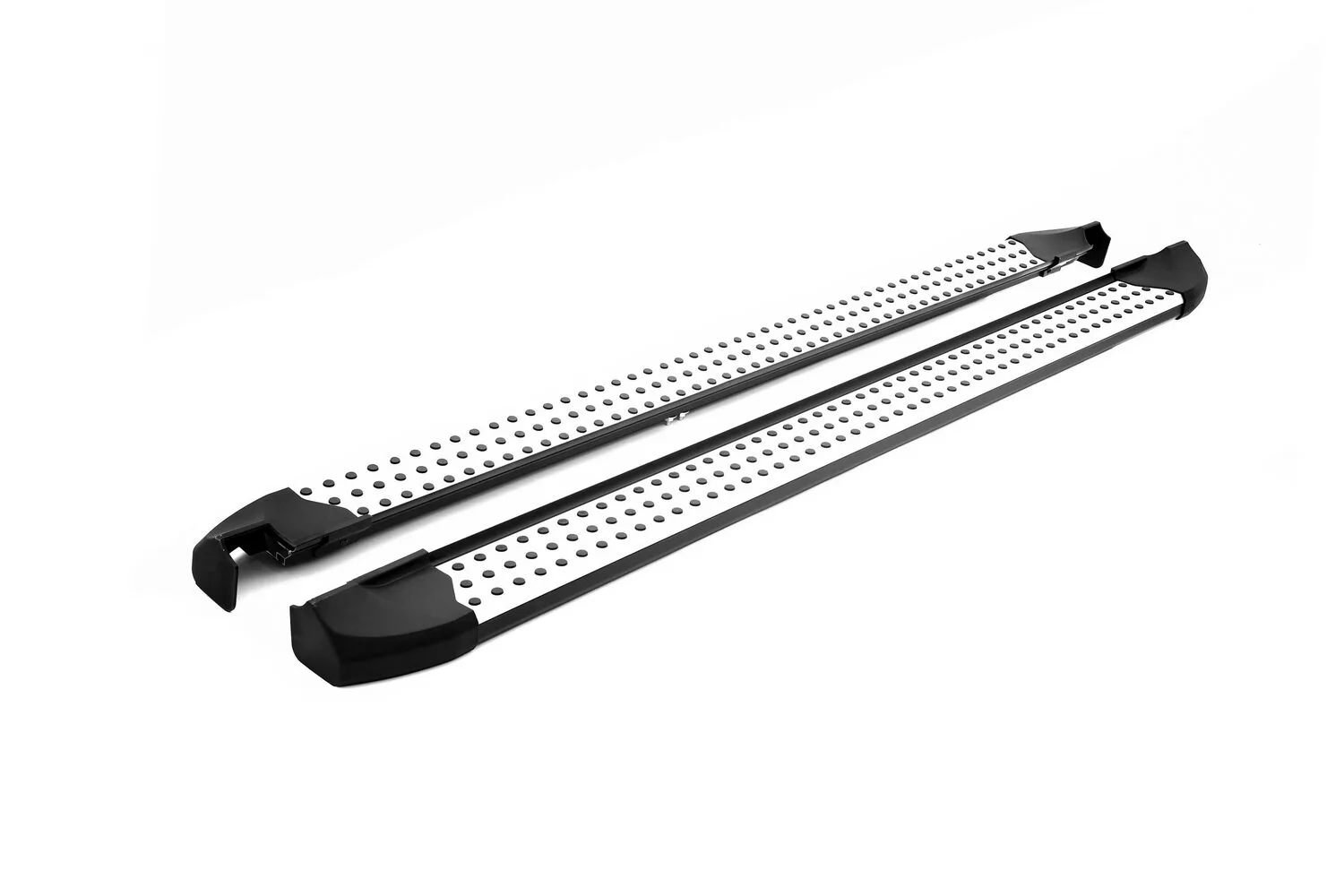Side steps on vehicles are particularly useful accessories for taller vehicles. Offering both aesthetic and functional benefits, these accessories provide various advantages—from easing entry and exit to protecting the vehicle’s body. Side steps are an important element in terms of practicality and safety for users and come in different materials and designs to suit all types of vehicles.
Ease of Getting In and Out of the Vehicle
Getting in and out of tall vehicles can sometimes be challenging. For vehicles such as SUVs and pickup trucks, the height from the ground can be an obstacle, especially for the elderly, children, or individuals with limited mobility. The use of side steps provides easier access during this process. This allows everyone to enter and exit the vehicle more comfortably and safely. Additionally, in rainy or snowy weather, side steps help reduce the risk of slipping, thereby enhancing safety.
Easy Access to the Vehicle Roof
Accessing the roof of a vehicle can be difficult, especially when loading items onto a roof rack or cleaning the roof. In such situations, side steps offer a significant advantage. They make reaching the roof easier and make using a roof rack more practical. These steps provide a safe and stable platform, helping users maintain balance while working on the roof.
Protection of the Vehicle Body
Side steps serve as a protective barrier for the vehicle body against external impacts and environmental elements. They help minimize body damage caused by curbs and stones during parking or driving. Additionally, they prevent mud, rocks, and other environmental factors from damaging the paint, thereby preserving the vehicle’s exterior appearance. Among their many advantages, side steps also contribute to the longevity of the vehicle.
Advantages of Side Steps
Side steps offer a range of benefits to vehicle users. In addition to their functional advantages, they enhance the vehicle’s aesthetic appeal and help protect its surfaces.
Aesthetic Appearance
Side steps add a visual enhancement to the exterior of the vehicle. Stylish side step designs give the vehicle a modern and sleek look while complementing the overall design. Different styles allow for personalization of the vehicle’s appearance. Especially those made from materials like stainless steel or aluminum provide a sophisticated touch, enhancing the visual impression.
Protection of Vehicle Side Surfaces
Side steps protect the vehicle’s side surfaces from external elements. These accessories play a major role in surface protection, especially when frequently driving on rough terrain or parking in tight spaces. They help prevent scratches and damage to the sides of the vehicle. Side steps offer effective protection against mud, stone impacts, and road salt.
Increased Comfort for Passengers and Driver
Side steps provide added comfort for both driver and passengers. Especially for tall or elderly individuals, the extra step height offered by side steps makes entering and exiting the vehicle easier and more convenient. This makes the boarding process smoother and less physically demanding. Additionally, the support provided by the steps helps reduce strain on the legs, particularly in taller vehicles, which contributes to greater comfort on long journeys.
Types and Materials of Side Steps in Vehicles
Side steps are manufactured using various materials and come in different types. Each material has its own unique advantages and disadvantages. In this section, we will examine the characteristics of commonly used side step materials such as aluminum, plastic, and stainless steel.
Aluminum Side Steps
Aluminum side steps are known for their lightness and durability. These steps are also visually appealing. Their lightweight nature helps minimize fuel consumption, while their durability ensures long-lasting use. Particularly ideal for SUVs and light commercial vehicles, aluminum side steps provide a modern and stylish appearance.
Plastic Side Steps
Plastic side steps are popular due to their affordability and wide range of design options. In addition to being lightweight, these steps offer flexibility against impacts. However, in terms of durability, they generally have a shorter lifespan compared to metal materials. Still, because of their cost advantage and variety of color options, they are frequently chosen for custom designs.
Stainless Steel Side Steps
Stainless steel side steps stand out with their high resistance to corrosion and strong structural integrity. These steps are ideal for off-road and heavy-duty vehicles. A stainless steel side step maintains its durability for many years, even under harsh conditions, and complements the rugged look of the vehicle. Aesthetically, it provides a shiny and attractive appearance, adding a premium touch to the vehicle.
Usage Areas of Side Steps
Side steps are widely used across various vehicle categories such as SUVs, pickup trucks, commercial vehicles, and off-road vehicles. They are also preferred in modified vehicles for customization purposes.
SUVs and Pickup Trucks
As tall vehicles, SUVs and pickup trucks benefit greatly from side steps, which ease the process of getting in and out. In these vehicles, side steps also add an aesthetic appeal and serve to protect the side surfaces. Due to their high ground clearance, the convenience offered by side steps significantly enhances comfort in daily use.
Commercial Vehicles
In commercial vehicles, side steps provide major convenience during loading and unloading processes. Especially in transport vehicles, steps improve workplace safety by allowing employees to perform vehicle-related tasks more securely and efficiently. Additionally, the durability and strength of the steps reduce maintenance costs over time in commercial applications.
Off-Road Vehicles
For off-road vehicles, side steps offer both aesthetic and practical advantages. In challenging terrain conditions, they play a key role in protecting the vehicle body and enhancing driver comfort. Off-road-specific side step designs are commonly preferred in these vehicles, as they not only provide protection in harsh conditions but also contribute to a robust and rugged appearance.
Modified Vehicles and Custom Designs
In modified vehicles, side steps are customized according to the owner’s personal preferences. Modified vehicle side steps offer a personal touch with a variety of design and material options. These steps give the vehicle a unique look and add to its visual appeal.
How to Install Side Steps?
Side step installation can be completed in a few simple steps. The process begins with gathering the necessary materials and ends with mounting the steps onto the vehicle. In this section, we provide a step-by-step guide for side step installation.
Materials Required for Side Step Installation
The materials needed for installation are usually included in the mounting kits. These kits ensure that the side steps are securely attached to the vehicle. Each component within the kit plays a critical role in the installation process. Additionally, using the correct tools is essential for a successful installation.
Basic Tools and Equipment
Basic tools such as a wrench and screwdriver are required for installation. These tools ensure that the side steps are mounted correctly and securely. Using the wrong tools can result in an unstable installation.
Mounting Kits and Accessories
Mounting kits contain all the necessary hardware to properly attach the steps to the vehicle. These kits typically include screws, brackets, and other essential accessories. They ensure that the steps are securely fastened and fully compatible with the vehicle.
Step-by-Step Guide to Installing Side Steps
Installing side steps involves following a specific set of steps. Paying attention to key points and tips during the process ensures the steps are mounted correctly.
Preparation and Safety Precautions
Before starting the installation, safety precautions must be taken. This includes setting up a proper workspace, using protective equipment, and taking necessary safety measures. Being careful during the installation process protects both personal safety and the vehicle from damage.
Cleaning and Preparing the Mounting Surface
Cleaning the mounting surface is essential for securely attaching the steps to the vehicle. The area where the installation will be performed must be smooth and clean to ensure a stable and safe fit.
Identifying Mounting Points for the Side Step
It’s important to accurately identify and mark the mounting points. Incorrectly aligned points can lead to unstable steps. Therefore, ensuring precise alignment during installation is crucial.
Mounting the Side Step
During the mounting process, proper tools should be used and the correct steps must be followed. Each connection point must be tightly secured. Carefully following these steps ensures that the side steps remain securely in place and safe for long-term use.
Post-Installation Checks and Testing
After the installation is complete, the stability and alignment of the side steps must be thoroughly checked. In addition, performing tests after installation helps confirm the functionality and safety of the steps.
Important Considerations During Side Step Installation
There are several key points to pay attention to during the installation process. Special care should be taken regarding the alignment of the mounting points and the tightness of screws and connection points.
Correct Alignment of Mounting Points
Proper alignment of the mounting points prevents the steps from becoming unstable. Well-aligned mounting points ensure the steps remain durable and safe over the long term.
Tightness of Screws and Connection Points
During installation, the tightness of all screws and connection points should be checked. This ensures the side steps are securely mounted and helps prevent potential issues after installation.
Protection of the Vehicle Undercarriage
Protecting the vehicle’s undercarriage during installation is essential. Incorrect installation can damage the underbody of the vehicle. Therefore, care must be taken during the process, and necessary precautions should be followed to avoid harm.
Tips and Recommendations for Side Step Installation
There are several tips and suggestions that can make the installation process easier for users. Paying attention to these details helps ensure the process runs smoothly and efficiently.
Need for Professional Assistance
Seeking professional assistance during installation can ensure the process is completed more quickly and safely. For those installing side steps for the first time, professional support can be particularly helpful.
DIY (Do-It-Yourself) Installation Tips
For those who want to install side steps using the DIY (Do-It-Yourself) method, there are several practical suggestions and key points to keep in mind. When the correct steps are followed, DIY installation not only saves money but also offers personal satisfaction. However, this process does carry certain risks. Here are the main things to consider for a successful DIY installation:
- Carefully Review the Manuals: Thoroughly read the installation manual provided by the manufacturer. Each vehicle may have different installation requirements, so it’s essential to fully understand the instructions.
- Use the Right Tools and Equipment: Ensure that the tools and mounting kits used are appropriate for your vehicle. Using the wrong tools may result in an unsafe installation.
- Have an Extra Pair of Hands: Some installation steps—especially aligning the steps—may require help. Having someone assist you during installation can make the process much easier.
- Be Patient and Careful: Take your time and stay focused throughout the DIY installation. Rushing the process can lead to errors. Complete each step carefully to ensure safety.
The biggest advantage of DIY installation is cost savings. However, mistakes made during the process can lead to bigger problems down the line. Therefore, those without the necessary knowledge or experience should consider seeking professional assistance.
Post-Installation Regular Maintenance
Performing regular maintenance after installing side steps ensures their longevity and is important for safety. Here are some recommendations for maintaining your side steps after installation:
- Periodic Cleaning: Clean the side steps regularly. In winter, salt, mud, and dirt accumulation can cause corrosion on the surface. Use a soft brush and water to keep the steps clean.
- Check Connection Points: Over time, screws may loosen, so periodically inspect the connection points. Tighten the screws if necessary to maintain stability.
- Corrosion Inspection: Even materials like stainless steel can corrode over time. Regularly check the steps for signs of rust or corrosion and take appropriate measures if any issues are detected.
- Use Surface Protection Products: Apply protective sprays or polishes suitable for side steps to preserve their surface. These products help maintain a shiny, like-new appearance for a longer period.
Regular maintenance helps preserve the aesthetic and functional features of side steps, contributing to your vehicle’s safety and stylish appearance.


